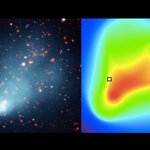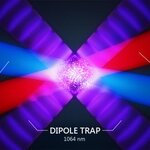Physics

The LHC has finally started to produce 13-TeV proton-proton collisions!
The picture below shows one such collision, as recorded by the CMS experiment today. The blue boxes show the energy recorded in the calorimeter, which measures particle energy by "destroying" them as they interact with the dense layers of matter that this device is made up of; the yellow curves show tracks reconstructed by the ionization deposits of charged particles left in the silicon detector layers of the inner tracker. For more pictures from CMS, see here.
Bang... The highest-energy man-made collision…

A new simulation that explains the collision between clusters of galaxies known as "El Gordo" also challenges popular thinking on the blanket term for undetected 'dark matter'.
In general, galaxy clusters grow in size by merging with each other due to gravitations forces despite the expansion of the universe. El Gordo is the biggest known cluster of galaxies, and is in turn the result of the collision between two large clusters. The simulation believes that the collision process compresses the gas within each cluster to very high temperatures so that it is shining in the X-ray region of…

Burton Richter, 1975 Nobel prize in Physics for the discovery of the J/ψ meson, speaks about the need of a new linear collider for the measurement of Higgs boson branching fractions in a video on Facebook (as soon as I understand how to paste here I will!)
Richter has been a fervent advocate of electron-positron machines over hadronic accelerators throughout his life. So you really could not expect anything different from him - but he still does it with all his might. At one point he says, talking of the hadron collider scientists who discovered the Higgs boson:
"Clearly they made it work…

I am very happy today because I have been notified by the European Community that a project I submitted for funding as coordinator last January has been evaluated very positively by the EU reviewers. The project is a training network of universities and research centres in Europe, with participation of two additional academic partners and four industrial partners from the US, Russia, Italy and Belgium. The network name is "AMVA4NewPhysics", and it aims at developing and applying cutting-edge statistical learning tools to new physics and Englert-Higgs boson studies to the LHC data collected…

Rydberg atoms, atoms whose outermost electrons are highly excited but not ionized, might be just the thing for processing quantum information. These outsized atoms can be sustained for a long time in a quantum superposition condition (a good thing for creating qubits) and they can interact strongly with other such atoms, making them useful for devising the kind of logic gates needed to process information.
Named for Swedish physicist Johannes Rydberg, these ballooned-up atoms are made by exciting the outermost electron in certain elements. Alkali atoms are handy for this purpose since…

“There are 10^11 stars in the galaxy. That used to be a huge number. But it's only a hundred billion. It's less than the national deficit! We used to call them astronomical numbers. Now we should call them economical numbers.”
Richard Feynman, who would turn 97 years old today. Happy birthday, mr. Feynman!

All light is made of electromagnetic waves. This means that like any wave, there is
something repeatedly sloshing back and forth with light. A water wave is crests and troughs on the
water going up and down over and over as they travel across the surface. Light waves have some resemblance in that
with light, it is electric and magnetic fields which are periodically wobbling
back and forth.
Light also happens to come in little individual packets of
energy known as photons. Each photon has
only a single portion of an electric and magnetic field which vibrate…

A new search for Higgs bosons in the context of two-higgs-doublet models has been carried out by the CMS collaboration at the CERN laboratory. This is not the first time that CMS searches for "the other four" Higgs bosons, which may arise if the standard model is just a tad less simple and elegant than it could be: recently, for instance, I have reported here of the search for the A bosonin final states including a "regular" higgs decay to b-quark pairs and a Z boson decay to electron-positron or muon pairs (and also reported the preliminary result earlier).You may…

When a mirror reflects light, it experiences a slight push but it is negligible in our everyday lives. Our furniture is not moving because due to radiation pressure of light, a 100 Watt light-bulb causes a radiation pressure that is only a trillionth (one part to 1000000000000) of the normal atmospheric pressure.
Radiation certainly pressure matters in space, the tails of comets typically point away from the Sun due to radiation pressure, and it has been proposed as the propulsion for solar sails, should we ever venture more than 400 miles from Earth again. On terra firma, radiation has…

As yesterday in Italy was the equivalent of Labor Day, and today is a Saturday, with people around me exploiting the three-day rest for a recreational trip, I do not feel in a very productive mood, so rather than writing something original here I will exploit other people's work, pointing at what I found interesting or anyway worth my attention among the papers appeared on the Cornell Arxiv in the last few days, and other assorted material.First of all, I was happy to see that the original CDF work on the bottom-quark asymmetry in proton-antiproton collisions, which I have discussed in some…